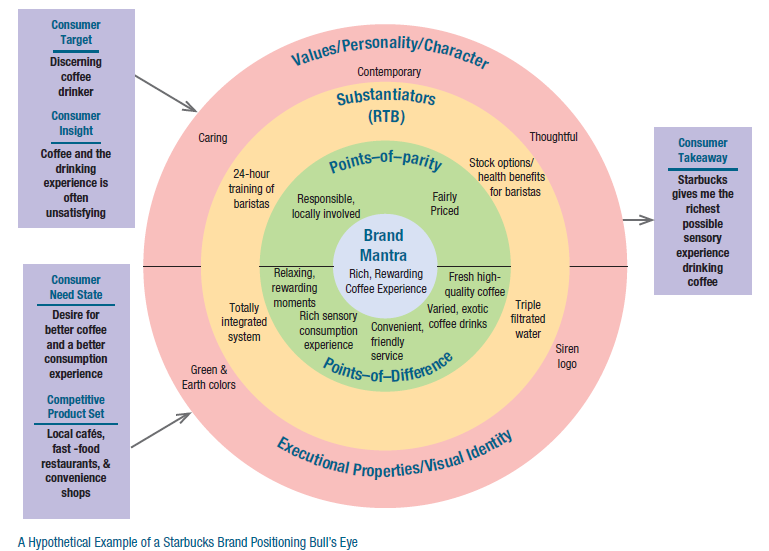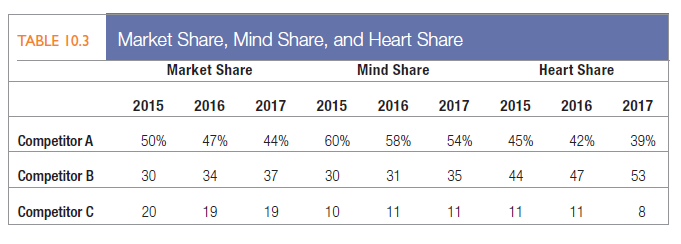Once they have fashioned the brand positioning strategy, marketers should communicate it to everyone in the organization so it guides their words and actions. One helpful schematic with which to do so is a brandpositioning bull’s-eye. “Marketing Memo: Constructing a Brand Positioning Bull’s-eye” outlines one way marketers can formally express brand positioning without skipping any steps.
Often a good positioning will have several PODs and POPs. Of those, often two or three really define the competitive battlefield and should be analyzed and developed carefully. A good positioning should also follow the “90-10” rule and be highly applicable to 90 percent (or at least 80 percent) of the products in the brand. Attempting to position to all 100 percent of a brand’s product often yields an unsatisfactory “lowest common denominator” result. The remaining 10 percent or 20 percent of products should be reviewed to ensure they have the proper branding strategy and to see how they could be changed to better reflect the brand positioning.
COMMUNICATING CATEGORY MEMBERSHIP Category membership may be obvious. Target customers are aware that Maybelline is a leading brand of cosmetics, Cheerios is a leading brand of cereal, Accenture is a leading consulting firm, and so on. When a product is new, marketers must inform consumers of the brand’s category membership.
Sometimes consumers may know the category membership but not be convinced the brand is a valid member of the category. They may be aware that HP produces digital cameras, but they may not be certain whether HP cameras are in the same class as those made by Canon, Nikon, and Sony. In this instance, HP might find it useful to reinforce category membership.
Brands are sometimes affiliated with categories in which they do not hold membership. This approach is one way to highlight a brand’s point-of-difference, providing consumers know its actual membership. Instead of putting it in the frozen pizza category, the marketers of DiGiorno’s frozen pizza have positioned it in the delivered pizza category with ads that claim “It’s Not Delivery, It’s DiGiorno!” Similarly, pay channel HBO has developed original, edgy programming to justify its premium fee, adopting the slogan “It’s Not TV, It’s HBO.”

The typical approach to positioning is to inform consumers of a brand’s membership before stating its point- of-difference. Presumably, consumers need to know what a product is and what function it serves before deciding whether it is superior to the brands against which it competes. For new products, initial advertising often concentrates on creating brand awareness, and subsequent advertising attempts to create the brand image. Ally Bank tapped into a distrust of financial institutions to stake out a unique positioning. 34
ALLY FINANCIAL In rebranding GMAC Financial as Ally Financial and launching its Ally Bank subsidiary, the firm initially ran a campaign featuring a smarmy man in a suit—who symbolically represented the typical bank—being mean to unsuspecting children—who symbolically represented typical bank customers. The idea was to show Ally Bank as simple and direct. One ad had the slick spokesperson sitting with two young girls at a small table asking one of them whether she wanted a pony. When the girl said yes, he gave her a small toy pony. When the other girl said yes, he gave her a real pony. The clearly unhappy first girl asked why she didn’t get a real pony, and the man answered, in effect, “You didn’t ask.” Having established initial awareness, the campaign developed its “straightforward” positioning with several follow-up ads relaying a “Your Money Needs an Ally” theme and touting customers’ ability to reach humans at Ally Bank instead of machines. In the “Dry Cleaner” ad, seemingly real customers of a dry cleaner are captured via hidden camera as they attempt to cope with a blender that a sign indicates they should use for help. The ad ends with the words “Ally Bank. Helpful People. Not Machines.”
There are three main ways to convey a brand’s category membership:
- Announcing category benefits—To reassure consumers that a brand will deliver on the fundamental reason for using a category, marketers frequently use benefits to announce category membership. Thus, industrial tools might claim to have durability, and antacids might announce their efficacy. A brownie mix might attain membership in the baked desserts category by claiming the benefit of great taste and support this claim by including high-quality ingredients (performance) or by showing users delighting in its consumption (imagery).
- Comparing to exemplars—Well-known, noteworthy brands in a category can also help a brand specify its category membership. When Tommy Hilfiger was an unknown, advertising announced his status as a great U.S. designer by associating him with Geoffrey Beene, Stanley Blacker, Calvin Klein, and Perry Ellis, recognized members of that category.
- Relying on the product descriptor—The product descriptor that follows the brand name is often a concise means of conveying category origin. Ford Motor Co. invested more than $1 billion in a radical new 2004 model called the X-Trainer, which combined the attributes of an SUV, a minivan, and a station wagon. To communicate its unique position—and to avoid association with its Explorer and Country Squire models— the vehicle, eventually called Freestyle, was designated a “sports wagon.”35
COMMUNICATING POPs AND PODs We saw above that one common challenge in positioning is that many of the benefits that make up points-of-parity and points-of-difference are negatively correlated. ConAgra must convince consumers that Healthy Choice frozen foods both taste good and are good for you. Consider these examples of negatively correlated attributes and benefits:

Moreover, individual attributes and benefits often have positive and negative aspects. For example, consider a long-lived brand such as La-Z-Boy recliners, Burberry outerwear, or the New York Times. The brand’s heritage could suggest experience, wisdom, and expertise as well as authenticity. On the other hand, it could also imply being old-fashioned and not contemporary and up to date.
Unfortunately, consumers typically want to maximize both the negatively correlated attributes or benefits. Much of the art and science of marketing consists of dealing with trade-offs, and positioning is no different. The best approach clearly is to develop a product or service that performs well on both dimensions. GORE-TEX was able to overcome the conflicting product images of “breathable” and “waterproof” through technological advances. When in-depth and quantitative interviews and focus groups suggested that consumers wanted the benefits of technology without the hassles, Royal Philips launched its “Sense and Simplicity” campaign for its Philips brand of electronics, using print, online, and television advertising.36
Other approaches include launching two different marketing campaigns, each devoted to a different brand attribute or benefit; linking the brand to a person, place, or thing that possesses the right kind of equity to establish an attribute or benefit as a POP or POD; and convincing consumers that the negative relationship between attributes and benefits, if they consider it differently, is in fact positive.
MONITORING COMPETITION Positioning requires an organizational commitment. It is not something that is constantly overhauled or changed. At the same time, it is important to regularly research the desirability, deliverability, and differentiability of the brand’s POPs and PODs in the marketplace to understand how the brand positioning might need to evolve or, in relatively rare cases, be completely replaced.
In assessing potential threats from competitors, three high-level variables are useful:
- Share of market—The competitor’s share of the target market.
- Share of mind—The percentage of customers who named the competitor in responding to the statement “Name the first company that comes to mind in this industry.”
- Share of heart—The percentage of customers who named the competitor in responding to the statement “Name the company from which you would prefer to buy the product.”
There’s an interesting relationship among these three measures. Table 10.3 shows them as recorded for three hypothetical competitors. Competitor A enjoys the highest market share but is slipping. Its mind share and heart share are also slipping, probably because it’s not providing good product availability and technical assistance. Competitor B is steadily gaining market share, probably due to strategies that are increasing its mind share and heart share. Competitor C seems to be stuck at a low level of market, mind, and heart share, probably because of its poor product and marketing attributes.

We could generalize as follows: Companies that make steady gains in mind share and heart share will inevitably make gains in market share and profitability. Firms such as CarMax, Timberland, Jordan’s Furniture, Wegmans, and Toyota are all reaping the benefits of providing emotional, experiential, social, and financial value to satisfy customers and all their constituents.37
MARKETING MEMO Constructing a Brand Positioning Bull’s-eye
A brand bull’s-eye provides content and context to improve everyone’s understanding of the positioning of a brand in the organization. Here we look at a hypothetical Starbucks example.
In the inner two circles is the heart of the bull’s-eye—key points-of-parity and points-of-difference as well as the brand mantra. Points-of-parity and points-of-difference should be made as specific as possible without being too narrow. A POD of “gives confidence” for P&G’s Bounty paper towels—known as the “Quicker Picker-Upper”—is very broad compared to the much more brand-relevant POD of “helps to relieve tense situations.”
Points-of-parity and points-of-difference should be constructed in terms of the benefits a customer would actually derive from the product or service. “Leading Brand in the Category” as a point-of-difference fails to answer the question: What’s in it for the customer? Does being the leading brand give the customer greater peace of mind, greater convenience, access to more innovative products, and/or social approval or self-respect from being associated with a “winner”?
Points-of-difference should also be stated in positive, aspirational terms, like “Irresistible Taste,” “Superior Value,” Tireless Customer Service,” and “Unimpeachable Trust.” Points-of-parity are often stated in more muted terms to recognize the potential deficiencies they represent, such as “Sufficiently Accessible,” “Appropriately Relevant,” and “Fairly Priced.”
In the next circle out are the substantiators or reasons-to-believe (RTB)—attributes or benefits that provide factual or demonstrable support for the points-of-parity and points-of-difference. Finally, the outer circle contains two other useful branding concepts: (1) the brand values, personality, or character— intangible associations that help to establish the tone for the words and actions for the brand; and (2) executional properties and visual identity—more tangible components of the brand that affect the way customers see it.
Three boxes outside the bull’s-eye provide useful context and interpretation. To the left, two boxes highlight some of the input to the positioning analysis. One includes the consumer target and a key insight about consumer attitudes or behavior that significantly influenced the actual positioning; the other provides competitive information about the key consumer need the brand is attempting to satisfy and some competitive products or brands that need suggests. To the right of the bull’s-eye, one box offers a “big picture” view of the output—the ideal consumer takeaway if the brand positioning efforts are successful.
Source: Kotler Philip T., Keller Kevin Lane (2015), Marketing Management, Pearson; 15th Edition.

It?¦s really a cool and useful piece of information. I?¦m satisfied that you simply shared this helpful info with us. Please stay us informed like this. Thanks for sharing.